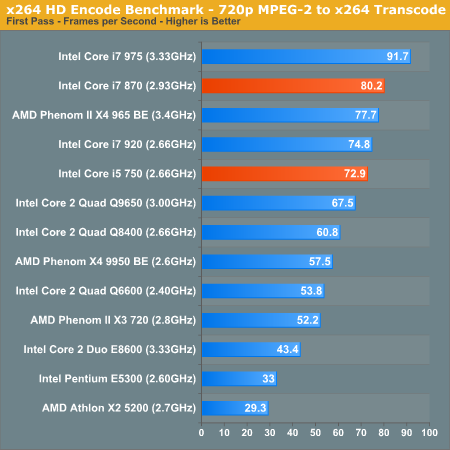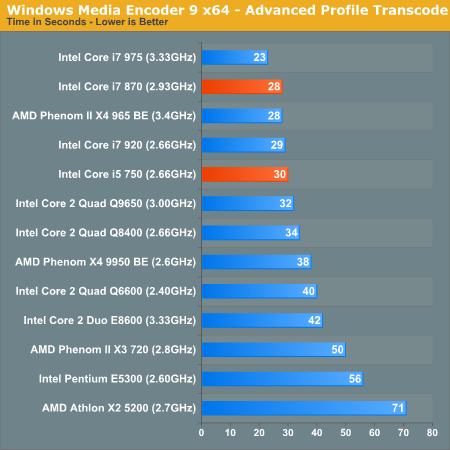Intel's Core i7 870 & i5 750, Lynnfield: Harder, Better, Faster Stronger
by Anand Lal Shimpi on September 8, 2009 12:00 AM EST- Posted in
- CPUs
DivX 8.5.3 with Xmpeg 5.0.3
Our DivX test is the same DivX / XMpeg 5.03 test we've run for the past few years now, the 1080p source file is encoded using the unconstrained DivX profile, quality/performance is set balanced at 5 and enhanced multithreading is enabled:

And we're done. DivX, historically a stronghold for AMD's Phenom II processors (at least compared to their price-competitive Penryn counterparts) is faster on the Core i5 750 than on the Phenom II X4 965 BE. What's wrong with that?
The i5 750 costs $199, the 965 BE costs $245. Intel is selling you more transistors for less than AMD is for once.
x264 HD Video Encoding Performance
Graysky's x264 HD test uses the publicly available x264 codec (open source alternative to H.264) to encode a 4Mbps 720p MPEG-2 source. The focus here is on quality rather than speed, thus the benchmark uses a 2-pass encode and reports the average frame rate in each pass.

In the first pass AMD is quite competitive, outpacing the i5 750, but when we get to the actual encode:

It's close, but the cheaper i5 750 is faster than the Phenom II X4 965 BE once again; Hyper Threading keeps the i7 920 ahead.
Windows Media Encoder 9 x64 Advanced Profile
In order to be codec agnostic we've got a Windows Media Encoder benchmark looking at the same sort of thing we've been doing in the DivX and x264 tests, but using WME instead.

AMD is about 6% faster than the i5 750 here, it looks like the Phenom II does have some hope left for it. Let's see how the rest unfolds...










343 Comments
View All Comments
ash9 - Tuesday, September 8, 2009 - link
As per Anand's article, "How Much Does it Cost to Build a P55 Motherboard?" Intel is getting around $50 min everytime a P55 board is sold with its new chips...nice, most folk wont link board prices to Intel..way to go Intel; so how much is Intel really making on its $196 i5??JonnyDough - Tuesday, September 8, 2009 - link
I love you.Avalon - Tuesday, September 8, 2009 - link
Hey Anand, how did you test stability on your max i5 750 overclock with turbo mode enabled? You said your max overclock on your i5 75 with turbo was 3.2Ghz. Do you just simply run Prime or some similar burn in that runs on all 4 cores (which would have turbo'd you to 3.96Ghz), or did you actually check a single threaded run on a single/two core(s) at 100% while getting it to run at turbo speed of 4.16Ghz(4Ghz for 2) at the same time? Thanks!Gary Key - Tuesday, September 8, 2009 - link
Stability testing is accomplished by running large renders in Lightwave 3D 9.6 x64 and Cinema4D R11 x64 at the same time while playing FarCry 2 in a window, along with Espresso, Mainconcept Reference, Lightroom, several IE windows, and Maya opened in the background. Also, it was not shown but all of the overclock results were with an 8GB memory load at DDR3-1800 or above. We try to test them like you use them. ;)Anand Lal Shimpi - Tuesday, September 8, 2009 - link
When turbo mode was enabled we made sure the system was stable with 1, 2 and 4 cores active. It had to pass all tests to be considered stable.Take care,
Anand
chizow - Tuesday, September 8, 2009 - link
Comments like this make me think you're losing touch Anand.[quote] I'm going to go ahead and say it right now, there's no need for any LGA-1366 processors slower than a Core i7 965[/quote]
[quote]For $196 you're getting a processor that's faster than the Core i7 920. I'm not taking into account motherboard prices either, which are anywhere from $50 - $100 cheaper for LGA-1156 boards. I don't believe LGA-1366 is dead, but there's absolutely no reason to buy anything slower than a 965 if you're going that route.[/quote]
There's about 800 reasons I can think of for other LGA1366 chips besides the Core i7 965, and there was a time you tipped your hat to amazing value gained from overclocking. I guess you're too enamored nowadays throwing that money away on those overpriced $1500 Intel Nehalems on boring Mac platforms that aren't conducive to user modifications to begin with.
jordanclock - Tuesday, September 8, 2009 - link
I fail to see how Anand is "losing his touch." He has a very valid point: Buying anything less than the highest range i7's doesn't make sense right now. Lynnfield is very competitive to the sub-965 i7's, but with a much lower price (for both the CPU and motherboard). The 965/975 have many situations where they out-perform the i5's by a great deal, but unless you're buying a CPU for extreme performance, the i5 is a much better deal no matter how you slice it.chizow - Tuesday, September 8, 2009 - link
It seems you missed the point, entirely. Once you factor in overclocking, there is about 800 reasons to buy a cheaper LGA1366 CPU than the i7 965 because those cheaper processors tend to reach the same maximum clockspeeds as their overpriced siblings. Even a modest 500-600MHz overclock on a "pointless" $200 i7 920 surpasses the performance level you could buy with a $1000 stock XE part from Intel. Failing to acknowledge this reality tells me both you and he are losing touch....Anand Lal Shimpi - Tuesday, September 8, 2009 - link
Forgive me as apparently I wasn't clear enough in what I was trying to say there.I would absolutely recommend the Core i7 920 over a $1000 Core i7 Extreme. In fact, I did back when the Core i7 first launched.
What I was trying to say in those sentences was Lynnfield changes all of that. Instead of buying a Core i7 920, I'd recommend a Core i5 750 (and saving money) or a Core i7 860 (and saving a bit less money). Those are both LGA-1156 processors.
The only reason anyone would want LGA-1366 is if they want to build something faster than a Core i7 870, which only leaves the Core i7 965/975.
My recommendation *isn't* to buy a $1000 CPU, it's to buy something much cheaper. Because of this, most of the LGA-1366 lineup is made obsolete by Lynnfield.
Does that make more sense?
Take care,
Anand
chizow - Tuesday, September 8, 2009 - link
I see your point and thought it might be what you were hinting at, but the message did come off awfully distorted with the way it was worded. If there was a 3.2-3.3GHz Lynnfield I suppose that would have made the 965 XE obsolete as well? The reality of it is, if there weren't other options besides $1000+ XE CPUs, X58 would be a dead platform akin to other failed Intel efforts of the past like Skulltrail.But that's not the case. X58 still has a place even though performance overlaps with Lynnfield on the low-end. In multi-GPU and gaming situations there's still clearly a place for X58/LGA1366 as Page 9 indicates. In situations where the end-user intends to overclock, any of the artificial gains from Lynnfield's Turbo modes are going to be negated.
Personally, from a consumer standpoint, I feel Intel botched the whole X58/P55 design and launch starting with the decision to go with 2 sockets. Not only did the feature that provided the least benefit (triple vs. dual channel) drive the reason for the socket/pin count difference, they gimp the platform with superior tech by cutting PCIE lanes in half.
I would've much rather have seen a 32-lane integrated PCIE controller on X58 and have a unified LGA1188 socket instead of 2 sockets, both of which have blemishes and signficant downsides as we have now.